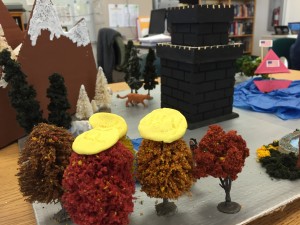International Baccalaureate Programs Finding A Home In Florida Middle and Elementary Schools
It’s game day in the 8th grade International Baccalaureate design class at Ada Merritt K-8 Center in Little Havana in Miami.
The games the students are playing are designed by their classmates. And they’re based on books the students read for class.
Four eighth graders prepare to set off on a board game based on the book “Everlost” – set in a fantasy world between life and death inhabited by “afterlights.”

John O'Connor / StateImpact Florida
Ada Merritt K-8 Center 8th graders Theo Urquiza and Victoria Fernandez play a role-playing game based on the book "Everlost" that their classmates created.
Theo Urquiza reads the rules and introduces the characters.
“Every player must choose one character,” Urquiza reads, “and once you have chosen a character go to the table of contents to see what page your player is on.”
“So, who’s Allie?” he asks.
“Ok, Allie,” he continues, and reads the character description. “Although Allie is dead, she’s not really dead. She got stuck in between life and death in a world called Everlost.”
Students were asked to create a role-playing game – where players live in the heads of the characters they’re playing with.
In this game, the players face a series of scenarios as the move along the board. They make a choice, and the outcome is decided by a roll of the dice.
Their choices are supposed to be based on the character’s motivations and actions from the book.
Assignments like this are one reason International Baccalaureate programs are growing in popularity.
It started in Switzerland in 1968, and the curriculum is the same in schools all over the world.
The Florida League of International Baccalaureate Schools says students in the Sunshine State are more likely to have access to IB classes than any other school system in the world.
Florida has pushed students to take more challenging courses to make sure they are ready for college or the workforce.
High schools can boost their state rating if more students take advanced classes.
And more elementary and middle schools are adding International Baccalaureate programs.
Their teacher is Bridget Kinney. She’s says the game assignment is representative of the International Baccalaureate philosophy.
“They use critical and creative thinking skills,” she says. “They use collaborative skills. They use communication skills…in every class. And that is a really big part of IB education.”
School districts have added IB programs for a lot of reasons.
International Baccalaureate has helped desegregate schools. In 1980s, the Pinellas County school district was under a federal court order to desegregate. So they opened Florida’s first IB program at St. Petersburg High to attract white students to the mostly black school – and it worked.
High school students who earn the IB diploma automatically qualify for Bright Futures, Florida’s lottery-funded college scholarship.
And demand is growing for IB programs in middle and elementary schools – like the one at Ada Merritt K-8.
Kinney says she likes the program’s philosophy – like forcing students to stop and reconsider their work by watching classmates play their game.
“They were able to see what problems they hadn’t anticipated and go back to the planning stage to solve them,” she says
Back in the world of Everlost, just as Alexander Otero is about to win the game, he runs into a problem. The Marauders block his way.
“Ok, you have to get an even number on the dice to beat them, but remember if you get an odd number you go to the start,” Urquiza warns him.

John O'Connor / StateImpact Florida
One team created an elaborate map to serve as the board for their game.
“What?” Otero responds, surprised.
He rolls the dice. Five.
“Nooooo!” Otero wails.
He has to go all the way back to the start.
When it’s time to tell classmates what they thought of the game, Theo Urquiza points out the trap at the end.
“I also think that this situation right here, that made Alex go all the way to start…
“To make the game last a long time,” Julian Roch-Hernandez cuts in, defending his team’s game.
“I did that specifically at the end for that specific purpose,” Roch-Hernandez says. “So that you’re like, ‘Oh man, I have to go through the board again.”
Kinney says she liked how many different kinds of games her students came up with. One had an elaborate map, while another had no board at all. All the games captured the essence of the books.
The next project? Making animated videos using paper cut-outs — like the early episodes of “South Park.”